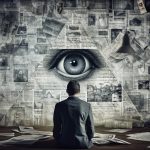Belief in conspiracy theories is a widespread phenomenon influenced by a complex interplay of cognitive and social factors. Here’s an exploration of the key elements that explain why people are so prone to believing conspiracy theories.
Humans tend to recognize patterns, even in random or ambiguous stimuli. This cognitive bias leads people to identify connections where none exist, making conspiracy theories appealing as they often provide a clear, though false, explanation for complex events. Individuals who have a high need for cognitive closure prefer definitive answers and dislike ambiguity. Conspiracy theories provide a sense of closure and certainty by offering clear explanations, satisfying this psychological need.
Proportionality bias involves the belief that significant events must have equally significant causes. For example, the idea that a major event like the assassination of a president cannot be the result of a lone culprit fits into this bias, making elaborate conspiracy theories more convincing than simple explanations.
Believers in conspiracy theories often experience cognitive dissonance when faced with evidence contradictory to their beliefs. To reduce discomfort, they may double down on their conspiracy beliefs or reinterpret new information in a way that supports the theory. People tend to seek out information confirming their beliefs and ignore evidence contradicting them. Confirmation bias reinforces belief in conspiracy theories by leading individuals to favor information that supports the theory and dismiss contradictory evidence.
Belief in conspiracy theories can be also influenced by one’s social identity. People may adopt conspiracy theories that align with the beliefs and values of their social group. This alignment fosters a sense of belonging and reinforces group identity. Conspiracy theories often posit a conflict between an in-group (the believers) and an out-group (those believed to be conspiring). This dynamic reinforces the in-group’s sense of cohesion and validates their belief system, further entrenching the conspiracy theory. The spread of conspiracy theories can be accelerated by social influence. Friends, family, and influential figures can shape individuals’ beliefs by sharing and endorsing conspiracy theories, especially on social media platforms.
Many conspiracy theories arise from a general **distrust in authority** and official explanations. Historical instances of actual conspiracies or governmental deceit can fuel skepticism, making people more likely to believe in new conspiracy theories. Conspiracy theories often evoke strong emotions such as fear, anger, or resentment. These emotional responses can make the theories more memorable and persuasive, as people are more likely to believe and spread information that elicits a strong emotional reaction.
Repeated exposure to a false claim can increase its perceived truthfulness. This illusory truth effect makes people more likely to believe in conspiracy theories if they encounter them frequently, regardless of the source’s credibility. Social media and online communities can create “echo chambers” where people are exposed only to information and opinions that reinforce their existing beliefs. These environments can amplify conspiracy theories by limiting exposure to dissenting viewpoints and factual information.
The interaction between cognitive biases and social influences creates a reinforcing loop that strengthens belief in conspiracy theories. For example, social identity can enhance confirmation bias, as people seek out information that aligns with their group’s beliefs. Similarly, cognitive biases like pattern recognition and proportionality bias can make emotionally charged and socially endorsed conspiracy theories more convincing.
Belief in conspiracy theories is a multifaceted phenomenon driven by cognitive biases and social dynamics. Understanding these factors can help in developing strategies to address and mitigate the impact of conspiracy theories on individuals and society.
